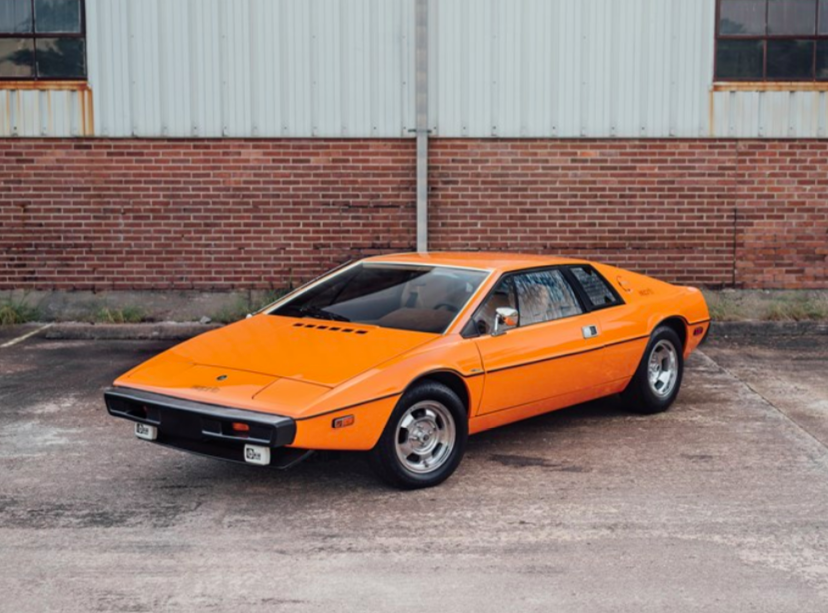-
Insurance
InsuranceAbout our productsLearn about insuringGet a quote Get current values, historical values, model history and more.
-
Valuation
ValuationHagerty valuation toolLook up a vehicle value Get current values, historical values, model history and more.
-
Events
EventsHagerty official eventsHagerty ClubhouseEvent calendar
-
Entertainment
EntertainmentMore to explore
- Portal login
1984 Lotus Esprit
S3 Coupe 2.2 L
Vehicle values by condition
Fair
Condition 4
£12,800
#4 cars are daily drivers, with flaws visible to the naked eye. The chrome might have pitting or scratches, the windshield might be chipped.
Good
Condition 3
£18,700
#3 cars could possess some, but not all of the issues of a #4 car, but they will be balanced by other factors such as a fresh paint job or a new, correct interior.
Excellent
Condition 2
£26,700
#2 cars could win a local or regional show. They can be former #1 cars that have been driven or have aged. Seasoned observers will have to look closely for flaws.
Concours
Condition 1
£44,200
#1 vehicles are the best in the world. The visual image is of the best car, unmodified, in the right colours, driving onto the lawn at the finest concours.
Insurance premium for a
1984 Lotus Esprit S3 Coupe 2174
valued at £18,700
£225.64
/ year*
History of the 1981 - 1987 Lotus Esprit

1981 - 1987 Lotus Esprit
By the early 1970s, Lotus’s product line was becoming distinctly old. Both the Elan and the Europa had been on the market for more than five years and both had been sold in kit form to avoid VAT. The rather unconventional look of the Europa was also seen as a hindrance to greater sales. World economics had also forced Lotus to compete at a price point that approached the cost of the much more professionally executed mainstream cars from Porsche. A new model was needed to change Lotus’s image and focus greater attention on the Hethel marque.
Enter the 1976 Lotus Esprit. The new Lotus wore sharp wedge styling courtesy of Ital Design’s Giorgetto Giugiaro, and looked almost just like the stunning 1972 concept car. Engineers mid-mounted the 2.0-litre, 4-cylinder Lotus 907 engine (for which Jensen-Healey buyers had unknowingly acted as uncompensated R&D specialists) and coupled it to a Citroen-sourced 5-speed gearbox. Build quality on these early S1 Esprits was mixed. The two-piece, glass fibre coachwork (the two halves were joined at the centre-line) was quite good, especially on the so-called “gel-coat” cars which had colour applied directly to the molds. The Spitfire and TR7 sourced switchgear, Morris Marina door handles and Fiat X1/9 tail lamps, however, probably appealed only to the notoriously cheap Colin Chapman and those who have to foot the bill today to replace these bits, which remain reasonably priced.
The usual Lotus frailty was still very much in evidence (ask anyone who has had to repeatedly replace a tiny line that feeds the mechanical oil pressure gauge, the red nylon clutch hose, or a worn-out faux suede Marcasite interior), so in the end the Esprit still didn’t manage to broaden the marque’s appeal much beyond the Europa or totally shed the kit car reputation of early Lotuses. What the Esprit did have going for it, in addition to its stunning looks, was a performance that could nearly match an 8-cylinder Ferrari 308 or Lamborghini Urraco while getting twice the gas mileage and costing a fair bit less. Another area in which the Esprit excelled was its brilliantly compliant ride and sharp handling. Both are remarkable even by modern standards.
As usual, the Americans due to emissions laws got a compromised version of the car with longer bumpers and a pair of leaned out Zenith-Strombergs in place of the Dell'Ortos the rest of the world got. It mattered little as the detoxed Federal Esprit still managed to keep pace with the equally emasculated Maserati Merak, Ferrari 308 GT/4 and Lamborghini Urraco.
The S2 of 1978 brought with it evolutionary changes like bespoke wheels by Speedline that replaced the rather vulgar Wolfrace wheels and additional cooling inlets on the sail panels, but the biggest change to the original Giugiaro Esprit occurred in 1980 when engine displacement increased to 2.2 litres and a turbocharger was added to the model lineup. With the introduction of the turbo, the car’s complexity increased, but finally the car’s performance was wholly commensurate with its looks.
The Giugiaro Esprit continued until a redesigned model was introduced in 1987. The early cars, however, remain one of the purest expressions of the 1970s wedge theme. And while the Lotus Esprit can certainly be classified as an exotic, parts and maintenance are nowhere near Ferrari levels. As such, this car remains a popular vintage option.
All 1984 Lotus Esprit body types
| Year | Make | Model | Submodel | Body Type | Engine size | Average value |
|---|---|---|---|---|---|---|
| 1981 | Lotus | Esprit | S3 | Coupe | 2.2 L | £ 12,800 18,700 26,700 44,200 |
| 1980 | Lotus | Esprit | Turbo | Coupe | 2.2 L | £ 12,300 20,000 32,000 42,000 |
Hagerty Newsletter
Get your weekly dose of car news from Hagerty UK in your inbox

ADVERTISEMENT